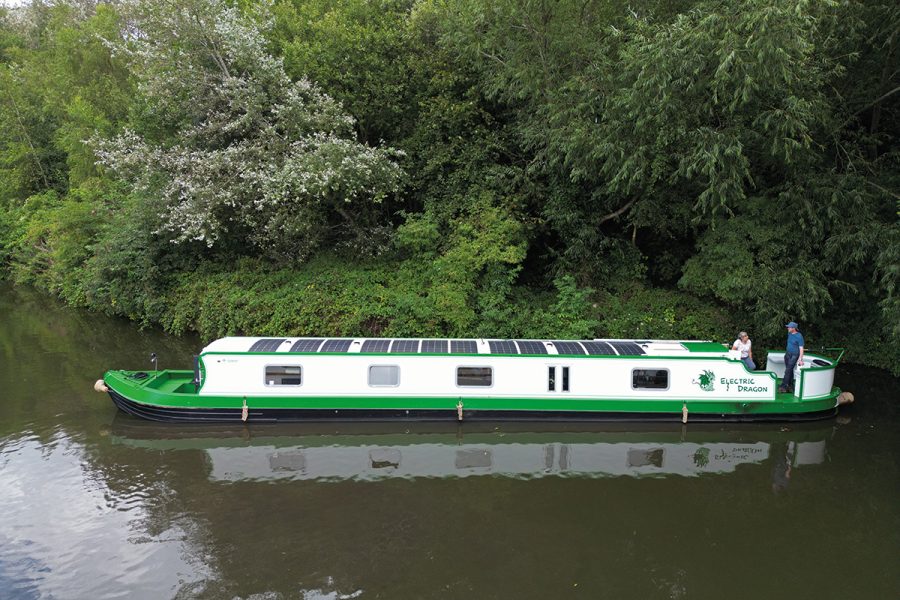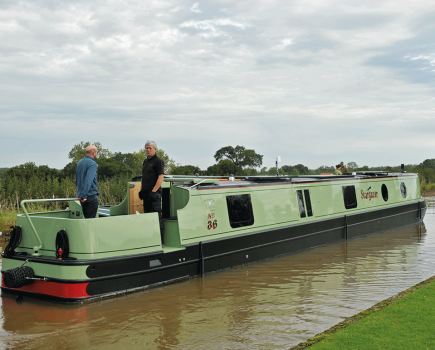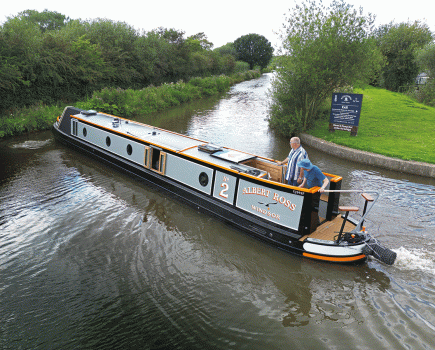The shell is the last one to be built by Jim Sparkes, so, quality is assured on this 60ft serial hybrid boat.
Words by Adam Porters | Pictures by Andy Annable
Whether you’re buying a new boat or a used one, there are all sorts of things to consider – from the layout and the fixtures and fittings to the engine type and the colour. But arguably one of the most important, the shell, is one of the things people spend the least amount of time thinking about.
It’s true that people can get exercised about stern type, but when it comes to the underwater shape of a boat, most people hardly give it a thought. But the shell is one of the few things you can’t easily change on a boat. You can repaint it, you can take out shelves and put in cupboards, and you can swap one sort of batteries for another. You can make your boat longer if you want (and we have covered a few boat stretches in this magazine over the years) but even those tend to leave the business ends of the shell alone.
That’s why it’s important to have a good quality shell, built by someone who knows what they’re doing. Until recently, one of those people was Jim Sparkes at Alexander Boats. We’ve always liked his shells, which look good and swim well. But after building boats for almost four decades, and supplying some of the top boat fitting firms in the country, Jim has hung up his welding gear and his overalls. And this boat, Electric Dragon, fitted out by Ortomarine, is the last shell he built. To mark the occasion, Ortomarine and the boat’s owners invited him down to Droitwich to see the boat launched.
While in many ways you might think boat building has remained pretty similar over the 40 years Jim Sparkes has been doing it, the finished products are now very different. The semi-cruiser stern is a fairly recent development, and this boat has electric propulsion, which would have been unheard of back when he started.
EXTERIOR
Electric Dragon is a 60ft boat. As you’d expect from an Alexander shell, the bow is an attractive shape with a substantial stem post. Together, the bow and well deck are long and elegant. As this is a gas free boat, the locker in the nose is available for storage, and offers plenty of it. The well deck has access to the bow thruster in a locker across the boat, and storage lockers both sides. One of these has the water filler inside; the water tank, which is stainless steel, is under the deck. There’s a nice curve to the forward edge of the cabin side, and there are also integral grab handles each side, to make it easier to get in and out of the well deck.
The stern is a semi-cruiser – meaning the rear deck is more enclosed than a cruiser would be, but without the full sides of a semi-trad. Instead, the cabin sides reduce in height in a series of steps with curves in between, and incorporate a grab handle in the final corner. Inside, there are lockers both sides, with cushions to make them somewhere comfortable to perch. A metal dodger encloses the rear of the deck, but it has a big cutout section so it doesn’t look heavy. The top of the dodger is a substantial metal rail, and inside there’s a curved bench with more cushions, a great place to sit once moored up. There are LED lights under the seat which bathe the deck in light, and more in the locker sides; they’re all remote controlled via the boat’s monitoring system, so you can switch them on as you return from the pub. There’s also LED lighting in the engine hole.
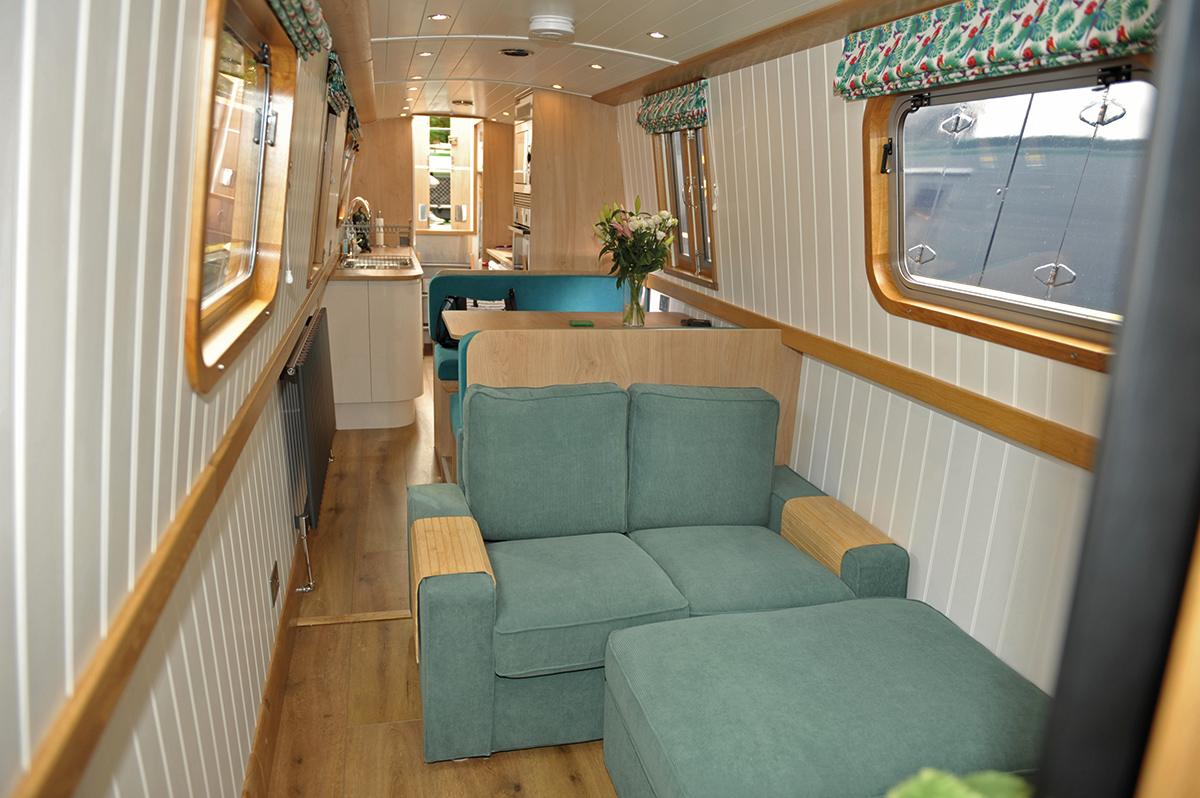
There’s nice detailing in other areas of the shell too, such as a finger grip along the handrails. And there are details you can’t see because they’re underwater – such as an S-shaped swim at the stern. This helps water move smoothly to the prop, and is only possible because of the small size of the electric motor; a diesel engine is too wide to accommodate the S.
The colour scheme is bright and modern, being mostly white teamed with a green which is at the same time both dark and bright. The windows are from Caldwell’s and have silver powder-coated frames. And the other trim matches, so the mushroom vents for example are stainless steel. They’re all the flat-topped ones, which add to the modern look of the boat.
LAYOUT AND FITOUT
This is a reverse layout boat, with the galley at the stern. Next comes a Pullman dinette, with the saloon beyond. The shower room is an off-corridor design, which we see relatively rarely these days. It means the room is a little smaller than a walk-through would be, but it has the advantage that you can always get from one end of the boat to the other, even if someone is using the facilities. The cabin is at the bow.
The fitout is bright and contemporary. Both above and below the gunwales there’s painted tongue and groove effect moisture resistant MDF, with more of the same (although in a slightly different shade of white) on the ceiling. All the trim is American white oak, which provides a nice contrast. The flooring is a rigid luxury vinyl tile, in an oak finish.
GALLEY
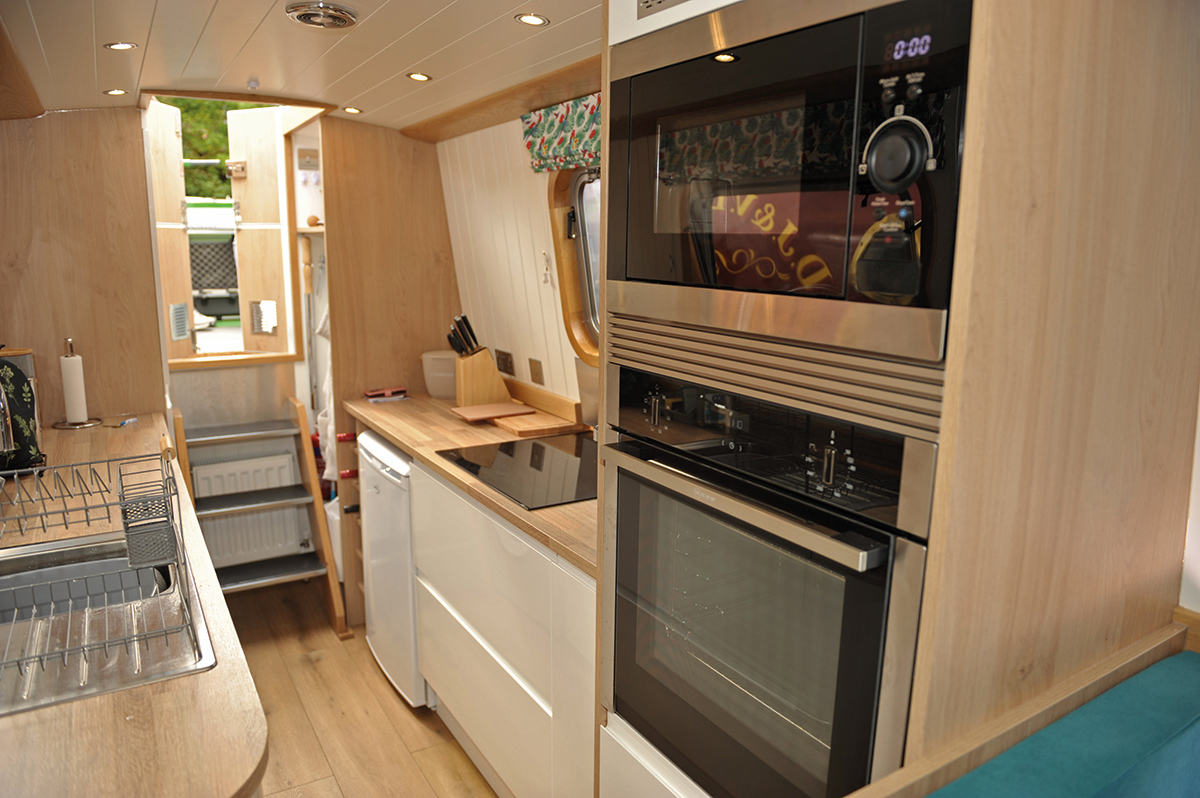 Steps lead down from the stern deck into the boat. On one side is an alcove where coats can be hung, and behind the panel is the electrical cupboard. There’s a screen here too for the boat’s monitoring system. On the opposite side is another cupboard, which has the calorifier in the bottom.
Steps lead down from the stern deck into the boat. On one side is an alcove where coats can be hung, and behind the panel is the electrical cupboard. There’s a screen here too for the boat’s monitoring system. On the opposite side is another cupboard, which has the calorifier in the bottom.
The galley units are from Howdens, adjusted by Ortomarine to fit the shape of the boat. The doors are in a white gloss finish, and have a handle-less design which means you won’t catch yourself or your clothes. The worktops are laminate, in an oak woodblock finish. As this is a hybrid boat with a plentiful electrical supply, all the galley equipment is electric. There’s a Neff oven with a slide and hide door, a Neff induction hob, and an Essentials microwave and grill. There’s a full size Zenith fridge and a separate full size freezer by the same maker. In addition, there’s a Quooker tap which provides boiling water; it has a vacuum tank under the sink which heats the water and keeps it heated – it’s actually a very efficient way of heating water because once the tank is hot, it’s only on for a few seconds at a time to maintain its temperature. It’s also water-efficient, because you’re never boiling more water than you need, like most people do most of the time with a kettle.
The blinds over the large windows give a splash of colour, thanks to a design featuring parrots and hummingbirds. They have magnets at the bottom to hold them against the cabin side.
DINETTE AND SALOON
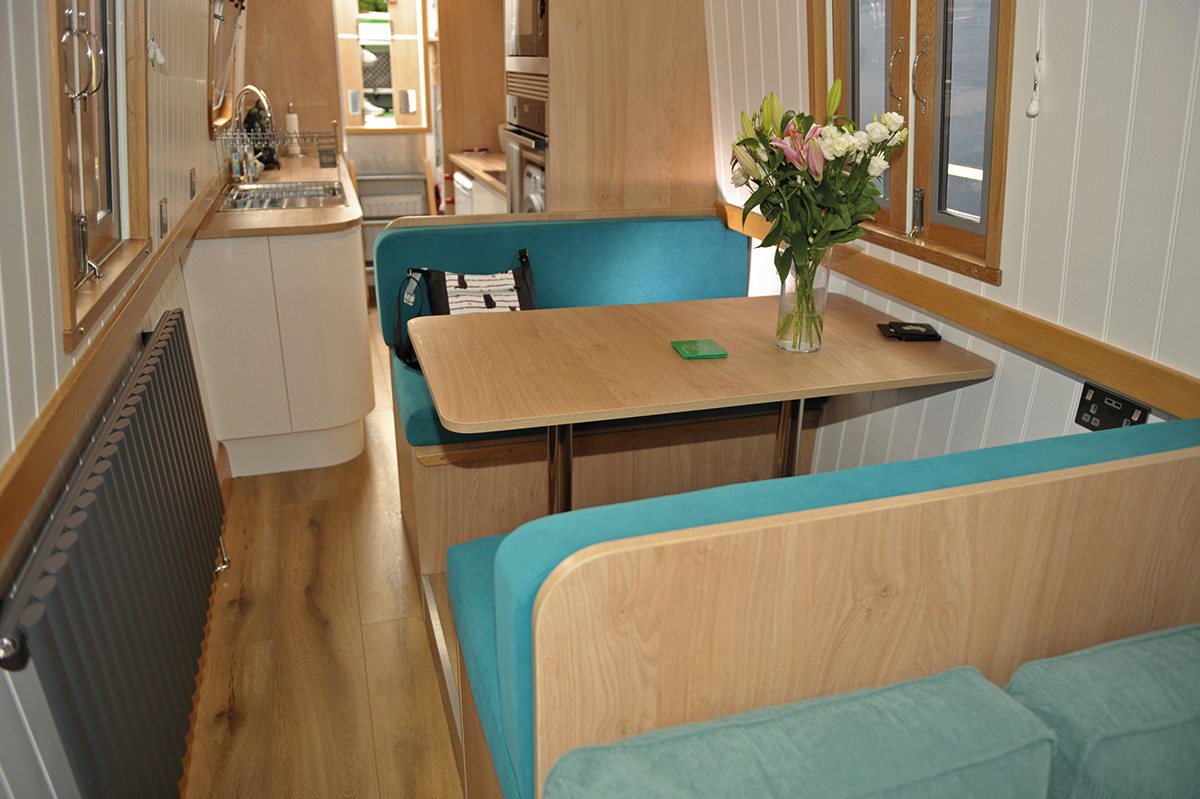 The Pullman dinette has bench seating both sides; one side offers storage, while the other is where the boat’s bank of lithium batteries live (about which more later). The large table drops down to convert the dinette into a guest bed. The teal fabric of the cushions picks up one of the colours from the blinds. There are glazed side doors both sides, and a smart grey column radiator.
The Pullman dinette has bench seating both sides; one side offers storage, while the other is where the boat’s bank of lithium batteries live (about which more later). The large table drops down to convert the dinette into a guest bed. The teal fabric of the cushions picks up one of the colours from the blinds. There are glazed side doors both sides, and a smart grey column radiator.
The saloon has an Ikea sofa set across the boat. It is perhaps a few inches wider than would be ideal. It also has an enormous footstool, which takes up a lot of space, but would provide extra seating. The forward bulkhead has a 43in Samsung smart tv mounted above the gunwale line, with a unit offering shelves and cupboard space.
There’s LED lighting under the gunwales, which gives the whole area a nice warm feel.
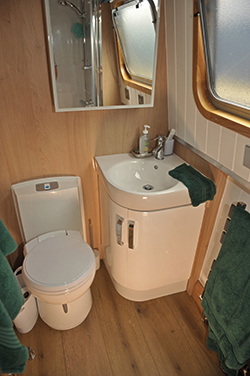 SHOWER ROOM
SHOWER ROOM
This is an off-corridor shower room, which we don’t see many of these days. Although they are necessarily smaller than a walk-through, they do have the advantage that you can get from one end of the boat to the other, even when someone else is making use of the facilities.
The loo is a Thetford cassette, which has a china bowl. Access to the cassette is in the cupboard in the saloon behind. A white basin tops a curved corner unit with storage, with a mirrored cabinet above. The shower cubicle is a generous 700x900mm, and has a mixer shower and laminate lined walls. Alongside, making use of the space between the cubicle and the hull side, are some shelves and access to the shower pump. There’s a towel rail under the gunwales.
As befits a bathroom, the parrots and hummingbirds give way on the blind to a selection of big fish!
CABIN
The cabin, at the bow, features a 4ft 6in wide bed with a memory foam mattress. The base lifts on gas struts to give access to the large amount of storage below. There’s a padded headboard which extends from the bed base right up to the high-level cupboards. These have reading lights below, and multiple USB charging ports in a cubby hole.
There are two full height wardrobes on one side of the boat, offering a combination of hanging space and shelves. On the opposite side is a low-height drawer unit with a mirror above. There’s some storage in the step up to the well deck, plus access to the water pump. The pump itself is a mains unit which makes just a gentle swishing noise as it works, rather than the hammering sound of a traditional diaphragm pump. The bow doors are a uPVC double glazed high security unit, white on the inside and anthracite on the outside.
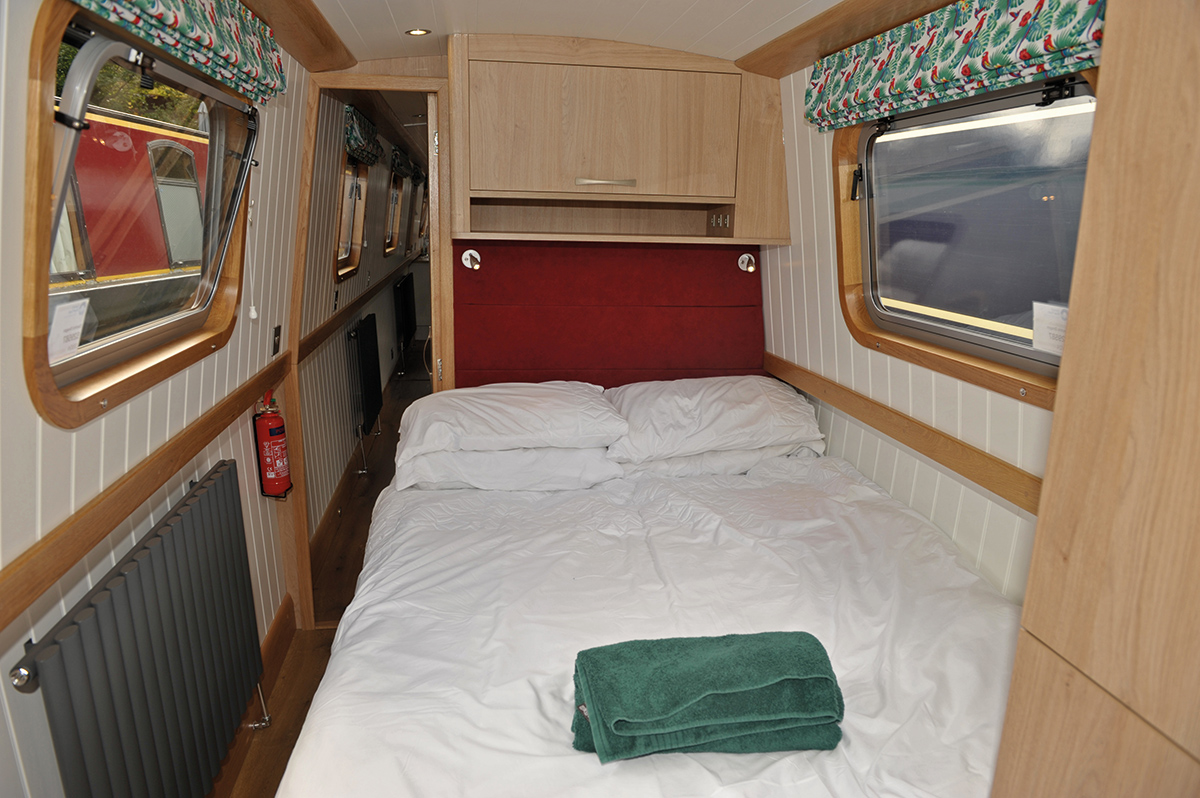
TECHNICAL
Electric Dragon is a serial hybrid boat, meaning propulsion comes purely from an electric motor, while a diesel generator provides charging for the batteries (when there’s not enough solar). Ortomarine have been specialising in hybrid boats for a while now, and have built a reputation for their expertise in this area. And expertise is needed, because putting together a combination of motor, generator, and batteries that works properly together is not as easy as it might sound.
In this case, the motor is a 48-volt unit by Engiro, offering 12kw continuous and 20kw peak output. It’s keel cooled. Also in the engine hole is a Fischer Panda 8000i variable speed generator. The variable speed element means the generator works as hard as a needs to, depending on the load – meaning it’s more fuel efficient.
The battery bank is 600Ah at 48volts, consisting of six 100Ah LiFePo4 batteries by Ritar, which are housed under the dinette bench. It’s better to have the batteries inside, as they don’t perform as well in the cold. Lithium batteries have the advantage of charging very quickly and being able to withstand being discharged to almost nothing – in comparison to lead acid batteries which should not be taken below 50 per cent. It’s also important to note that these are Lithium Iron Phosphate batteries, which have a different chemistry from the lithium-ions found in phones, computers, and cars, and which have developed something of a reputation for catching fire. The two are not the same. There’s a Victron 10kva inverter charger to provide a 240-volt supply.
As well as the generator, battery charging comes from 12×200 watt semi-flexible solar panels mounted on the roof. This means the array is 2.4kw in total, and in summer should mean the generator seldom if ever needs to be run. There’s a Victon MPPT controller.
Ortomarine have their own control system called OrtoMate, which ensures everything works together as it should. The screen at the stern shows you what’s going in and coming out of the batteries and what the solar is producing. It also means you can monitor everything remotely on your smartphone – and you can control things including the generator remotely too.
Speaking of remote control, the electric motor is fitted with the OrtoPilot system, so it can be controlled from the lock side using a handheld weatherproof unit. The bow thruster can be similarly controlled, giving you some left-right movement. This would be particularly useful for a single-hander.
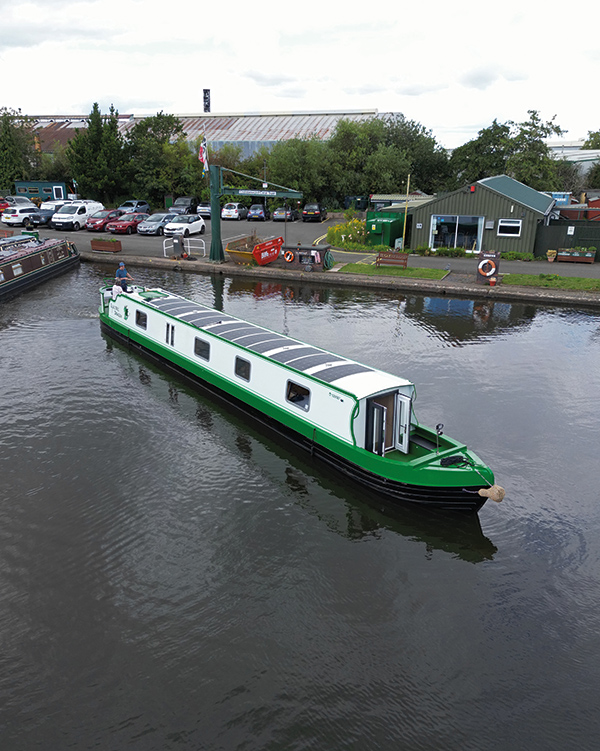 ON THE WATER
ON THE WATER
We didn’t have the opportunity to go far on our test, but we certainly put the boat through its paces in terms of manoeuvring, as we needed to turn several times and reverse for some distance. As you’d expect from an Alexander shell, the boat handles extremely well.
The electric motor is of course very quiet, but feels powerful enough. No matter the length of any cruise, it’s lovely to move so silently, and with the ability to hear what your fellow crew are saying, as well as people on the towpath. As with all electric motors, there’s a slight delay between moving the Morse control and anything actually happening, meaning that until you get used to it you tend to put on too many revs to start with.
CONCLUSION
There’s a lot to like about this very stylish boat. The white exterior and largely white interior are both bright and contemporary. The serial hybrid system makes the most of the latest technology and Ortomarine’s undoubted expertise. And the price, at around £200,000, represents good value for a boat with this level of kit. Interestingly, the owners say that cost was a factor in choosing lithium batteries, which have traditionally been many times more expensive than lead acids: lithiums are currently coming down in price, while lead acids are going up. A similar boat ordered right now might be a bit more, as the prices of many components are still rising.
As we said at the start, the one thing you can never really change on a boat is the shell, and this one has a very nicely built one. And while you will no longer have the option of an Alexander Boats shell for a new boat, you can bet that the reputation will live on, and existing Alexander shells will be sought after boats for many years to come.
The Owners
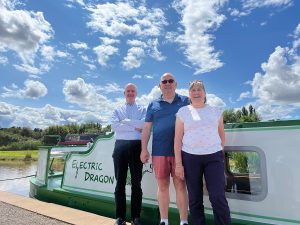 Karen and Bill Earl have an unusual boating history, in that all their boating has been done on Tuptonia, a 70ft boat owned by Girl Guides in Birmingham and Northamptonshire. Many boaters will have come across it, usually crewed by a large number of girl guides and their cheerful leaders. Both Bill and Karen were skippers for the boat, and have trained other skippers, so they know what they’re doing.
Karen and Bill Earl have an unusual boating history, in that all their boating has been done on Tuptonia, a 70ft boat owned by Girl Guides in Birmingham and Northamptonshire. Many boaters will have come across it, usually crewed by a large number of girl guides and their cheerful leaders. Both Bill and Karen were skippers for the boat, and have trained other skippers, so they know what they’re doing.
As the couple headed for retirement, they began planning their own boat. In 2019, Bill was seconded to a posting in Australia for work, and it was while they were there that they saw boat tests for Ortomarine’s electric powered boats and began to think this was the way to go.
Back in the UK, Karen has not gone back to her career as a driving instructor, but Bill is still working as a project manager sorting out the software requirements of hospitals. The boat has come along a little earlier than originally planned, before total retirement, as Karen lost her mother and the resulting inheritance meant they could afford it. And the boat is named in her honour: if she phoned and Bill answered she’d always say ‘it’s the dragon here’ – hence Electric Dragon, and the fact that the dragon painted on the boat is a friendly-looking one!
Specification
Length: 60ft
Beam: 6ft 10in
Shell: Alexander Boats
Style: Semi-cruiser
Fit-out: Painted MDF and oak
Electric motor: Engiro 48VDC 08016 / www.engiro.de
Generator: Fischer Panda 8000i PVMN-N / www.fischerpanda.co.uk
Inverter: Vetus 10kw / www.vetus.com
Bow Thruster: Quick BTQ185 / www.quickitaly.com
Water pump: Grundfos Scala 230VAC / www.grundfos.com
Galley units: Howden’s Clerkenwell gloss white / www.howdens.com £poa
Induction hob: Neff N50 T36FB41X0G / www.new-home.com £429
Boiling water tap: Quooker PRO3 flex / www.Quooker.com £1,150
Sofa: Ikea Kivik 2 seater / www.ikea.com £599
£200,000
CONTACT
Ortomarine
Unit 4A, Dursley Distribution Park
Curbs low Lane, Shenstone
Worcestershire, DY10 4DX
01299 489424
Info@ortomarine.co.uk
www.ortomarine.co.uk
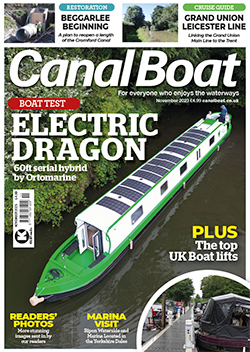 As featured in the November 2023 issue of Canal Boat. Buy the issue here
As featured in the November 2023 issue of Canal Boat. Buy the issue here

